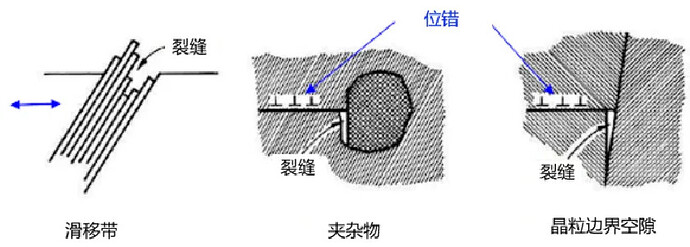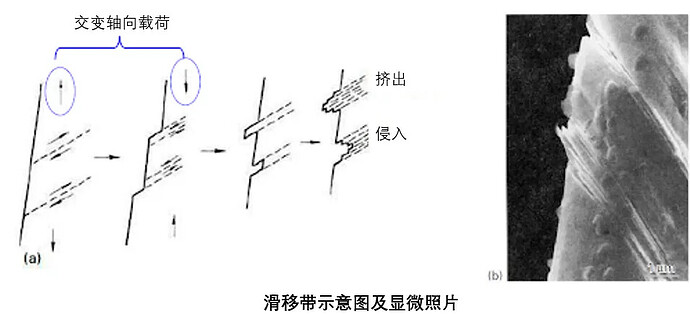Surface hardening is commonly understood as a way to increase the surface hardness of materials, enhancing their wear resistance. However, it is also an effective method for improving the fatigue strength of materials. Do you know why this is the case? Today, let’s explore the underlying mechanisms behind it.
The most common causes of fatigue crack initiation can be categorized into three types, as shown in the figure above. The first is dislocation slip at the material’s surface, while the other two are internal defects, such as inclusions and gaps at grain boundaries (like shrinkage cavities). Today, we will discuss the impact of surface hardening on fatigue strength, assuming there are no defects in the material; thus, dislocation slip will be our primary focus.
When a material is subjected to external forces, slip occurs on a microscopic scale. Slip bands are formed as they slide past each other, leading to extrusion and intrusion, as depicted in the figure below. These slip bands and the adjacent regions of extrusion and intrusion act as stress concentration points where cracks initiate and propagate. Since shear stress predominates, cracks typically form and grow at a 45° angle. Grains located at the surface of components are more susceptible to early defect formation due to the lack of support from surrounding grains compared to those within the material.
After surface hardening components, the hardness of the material significantly increases, and hardness is directly related to the strength of metals. The increase in hardness means an enhanced ability to resist plastic deformation. Compared to soft materials that have not undergone hardening, hardened materials are less likely to experience dislocation slip motion. Microscopic examinations typically show minimal extrusion or intrusion on hardened surfaces, which reduces stress concentration caused by slip bands and significantly lowers the likelihood of crack initiation. This is the primary reason why surface hardening can improve the fatigue strength of materials.
Additionally, there is a secondary reason: after quenching, the hardened surface usually develops residual compressive stress. This compressive residual stress also helps resist the initiation and propagation of fatigue cracks, thereby improving the material’s fatigue life.
However, there are two important points to consider: First, if the structural design of the components is not reasonable or if the quenching process is poorly controlled, cracking or micro-cracking may occur during hardening, becoming a source of fatigue failure. Second, if hardened components require precision machining, these operations could introduce micro-cracks (such as grinding cracks), alter hardness distribution, reduce residual compressive stress, or even lead to tensile stress, all of which can negatively impact fatigue strength.

